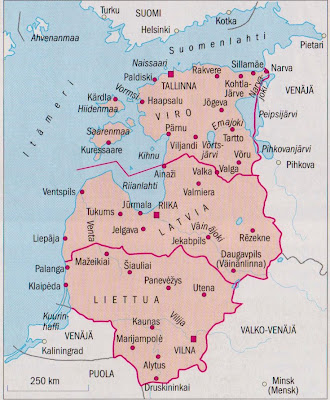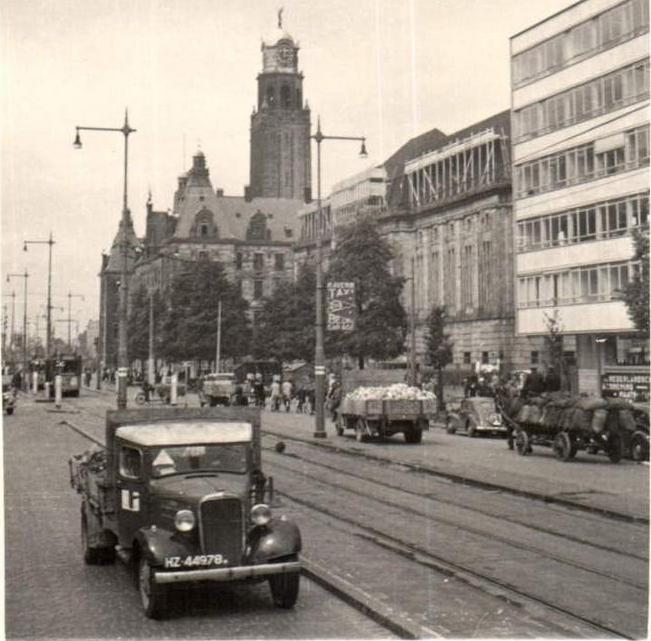Valkassa perustettiin Latvian väliaikainen kansallisneuvosto (Latviešu pagaidu nacionālā padome), joka päätti 30. tammikuuta 1918 muodostaa riippumattoman ja demokraattisen Latvian valtion, johon kuuluisivat kaikki latvialaisten asuttamat alueet.
17. marraskuuta demokraattinen rintama ja väliaikaisneuvosto päättivät yhdessä muodostaa parlamentin, Latvian kansallisen neuvoston (Tautas padome), ja seuraavana päivänä se antoi Latvian kansallisteatterissa Latvian eli ”Lättiläisen Liivinmaan” itsenäisyysjulistuksen.
Kansallisneuvoston puhemieheksi valittiin Jānis Čakste ja pääministeriksi Kārlis Ulmanis. Maailmansodan loppuvaiheessa maan olivat miehittäneet saksalaiset, ja näiden tukemat baltiansaksalaiset muodostivat oman maaneuvoston huhtikuussa 1918 ja kaappasivat vallan saksan tuella vuotta myöhemmin.
Latvia rifleman strelinieki 1918
Puna-armeija ajoi saksalaisia maasta ja bolsevikit julistautuivat maan hallitsijoiksi helmikuussa 1919.
Kolmen hallituksen välinen vapaussota päättyi Ulmanisin hallituksen voittoon heinäkuussa 1919. Saksa tunnusti maan itsenäisyyden heinäkuussa 1920 ja Neuvosto-Venäjän kanssa solmittiin rauha elokuussa 1920.
Latvia Hansa Brandenburg koneita
Latvian ilmavoimat Dornier Do-22
Vuonna 1934 Ulmanis kaappasi vallan, hajotti parlamentin määräämättömäksi ajaksi, kielsi poliittiset puolueet ja ryhtyi hallitsemaan maata diktatorisesti. Presidentti Alberts Kviesisin virkakauden päätyttyä vuonna 1936 Ulmanis otti itselleen perustuslain vastaisesti myös presidentin tehtävät.
Ulmanis pyrki diktaattorina lähentämään Latviaa natsi-Saksaan, mutta yritys kariutui Molotov–Ribbentrop-sopimuksen solmimiseen elokuun lopulla 1939.
Toisen maailmansodan sytyttyä Latvia julistautui puolueettomaksi.
Molotov–Ribbentrop-sopimuksen seurauksena Neuvostoliitto ryhtyi tavoittelemaan Latviaa haltuunsa. Lokakuussa 1939 solmitun sopimuksen nojalla se perusti Latvian länsiosiin ilma-, meri- ja maavoimien tukikohtia ja sijoitti niihin yli 25 000 sotilasta, enemmän kuin Latvian rauhanaikaisen armeijan vahvuus.
Neuvostoliitto valtasi maan 17. kesäkuuta 1940, perusti Latvian sosialistisen neuvostotasavallan ja käynnisti laajan terrorin. Latvian liittämistä Neuvostoliittoon johti varapääministeri Andrei Vyšinski. Valtionpäämies Kārlis Ulmanis vangittiin ja kuljetettiin Turkmenistaniin, jossa hän menehtyi pari vuotta myöhemmin; hänen tarkka kohtalonsa selvisi vasta Mihail Gorbatšovin kaudella 1980-luvulla.
Toisessa maailmansodassa Saksa miehitti Latvian heinäkuussa 1941. Latvian juutalaisista 90 % eli 80 000 henkeä likvidoitiin vuosina 1941–1942.
Sodan loppuvaiheessa perustettiin latvialainen Waffen-SS-joukko, joka taisteli Saksan puolella puna-armeijaa vastaan. Siihen värvättiin noin 100 000 miestä.
Neuvostoliitto valtasi Latvian uudestaan 1944–1945. Latvialaiset taistelivat pitkään puna-armeijaa vastaan, ja vielä 1953 osia maasta oli Puna-armeijan kontrollin ulottumattomissa.
Vuoden 1944 jälkeen lähes viidesosa latvialaisista pakeni länteen tai kyyditettiin itään, ja Neuvostoliitto tuotti maahan siirtolaisia muualta paikkaamaan syntynyttä työvoimapulaa sekä venäläistämään ja neuvostolaistamaan tätä osatasavaltaansa. Vuosien 1951 ja 1989 välillä Latviaan muutti 400 000 henkeä.
Useat länsimaat eivät koskaan tunnustaneet Baltian maiden liittämistä Neuvostoliittoon, sillä kansainvälisoikeudellisesti ne olivat teoriassa itsenäisiä kaikkien miehitysvuosien ajan.

-----------------------------------------
The international community (United Kingdom, France, Belgium, Italy and Japan) recognized Latvia's independence on January 26, 1921, and the recognition from many other countries followed soon. In this year Latvia also became a member of the League of Nations (September 22, 1921).
In April 1920 elections to the Constituent assembly were held. In May 1922 the Constitution of Latvia and in June the new Law on Elections were passed, opening the way to electing the parliament- Saeima. At Constituent Assembly, the law on the land reform was passed, which expropriated the manor lands.
Landowners were left with 50 hectares each and their land was distributed to the landless peasants without cost. In 1897, 61.2% of the rural population had been landless; by 1936, that percentage had been reduced to 18%.
The extent of cultivated land surpassed the pre-war level already in 1923.
Because of the world economic crisis there was a growing dissatisfaction among the population at the beginning of the 1930s. In Riga on May 15, 1934, Prime Minister Kārlis Ulmanis, one of the fathers of Latvian independence, took power by a bloodless coup d'état: the activities of the parliament (the Saeima) and all the political parties were suspended.
Latvija tanks
Rapid economic growth took place in the second half of the 1930s, due to which Latvia reached one of the highest living standards in Europe. Because of improving living standards in Latvian society, there was no serious opposition to the authoritarian rule of the Prime Minister Kārlis Ulmanis and no possibility of it arising.

Latvian Air Force. Note: the swastika was the official Latvian Air force sign and had nothing to do with Nazi Germany.
Swastika was used a prehistoric...
The Soviet Union guaranteed its interests in the Baltics with the signing of the Molotov–Ribbentrop Pact between the Soviet Union and Nazi Germany on August 23, 1939. Under threat of invasion, Latvia (along with Estonia and Lithuania) signed a mutual assistance pact with Soviet Union, providing for the stationing of up to 25,000 Soviet troops on Latvian soil. Following the initiative from Nazi Germany, Latvia on October 30, 1939 concluded an agreement to repatriate ethnic Germans in the wake of the impeding Soviet takeover.
Seven months later, the Soviet foreign minister Vyacheslav Molotov accused the Baltic states of conspiracy against the Soviet Union. On June 16, 1940, threatening an invasion, Soviet Union issued an ultimatum demanding that the government be replaced and that an unlimited number of Soviet troops be admitted. Knowing that the Red Army had entered Lithuania a day before, that its troops were massed along the eastern border and mindful of the Soviet military bases in Western Latvia, the government acceded to the demands, and Soviet troops occupied the country on June 17.

Soviet occupation of Latvia in 1940

Selections were held July 14–15, 1940, whose results were announced in Moscow 12 hours before the polls closed; Soviet documents show the election results were forged. The newly elected "People's Assembly" declared Latvia a Socialist Soviet Republic and applied for admission into the Soviet Union on July 21. Latvia was incorporated into the Soviet Union on August 5, 1940. The overthrown Latvian government continued to function in exile while the republic was under the Soviet control.

In the spring of 1941, the Soviet central government began planning the mass deportation of anti-Soviet elements from the occupied Baltic states. In preparation, General Ivan Serov, Deputy People's Commissar of Public Security of the Soviet Union, signed the Serov Instructions, "Regarding the Procedure for Carrying out the Deportation of Anti-Soviet Elements from Lithuania, Latvia, and Estonia."
The June deportation took place on June 13 and June 14, 1941, estimated at 15 600 men, women, and children, and including 20% of Latvia's last legal government. Approximately 35 000 total (1.8% of Latvia's population) were deported during the first Soviet occupation. Stalin's deportations also included thousands of Latvian Jews. (The mass deportation totaled 131 500 across the Baltics.)
According to the Serov Instructions, the deportations were swift and efficient and came in the middle of the night. Deportees were given an hour or less to get ready to leave. They were allowed to take with them their belongings not exceeding 100 kg in weight (money, food for a month, cooking appliances, clothing). The families would then be taken to the railway station.
That was when they discovered that the men were to be separated from the women and children: "In view of the fact that a large number of deportees must be arrested and distributed in special camps and that their families must proceed to special settlements in distant regions, it is essential that the operation of removal of both the members of the deportee's family and its head shall be carried out simultaneously, without notifying them of the separation confronting them ... The convoy of the entire family to the station shall be effected in one vehicle and only at the station of departure shall the head of the family be placed separately from his family in a car specially intended for heads of families."
The trains were escorted by a NKVD officer and military convoy. Packed into barred cattle cars, with holes in the floor for sanitation, the deportees were taken to Siberia. Many died before even reaching their final destination because of harsh conditions. Many more perished during their first winter.
A number of Latvians who managed to avoid deportations decided to hide in the forests, where anti-Soviet units were organized. When Nazi Germany attacked Soviet Union, those rebels immediately went into action"

Occupation of Latvia by Nazi Germany, The Holocaust in Latvia and Latvian resistance movement
During the night of 13–14 June 1941, 15,424 inhabitants of Latvia — including 1,771 Jews and 742 ethnic Russians — were deported to camps and special settlements, mostly in Siberia. 35,000 people were deported in the first year of Soviet occupation (131,500 across the Baltics).

The Nazi invasion, launched a week later, cut short immediate plans to deport several hundred thousand more from the Baltics.
Nazi troops occupied Riga on July 1, 1941. Immediately after the installment of German authority, a process of eliminating the Jewish and Gypsy population began, with many killings taking place in Rumbula.
Line of German Army trucks 1939
The killings were committed by the Einsatzgruppe A, the Wehrmacht and Marines (in Liepāja), as well as by Latvian collaborators, including the 500-1,500 members of the infamous Arajs Commando (which alone killed around 26,000 Jews) and the 2,000 or more Latvian members of the SD.
By the end of 1941 almost the entire Jewish population was killed or placed in the concentration camps. In addition, some 25,000 Jews were brought from Germany, Austria and the present-day Czech Republic, of whom around 20,000 were killed.
The Holocaust claimed approximately 85,000 lives in Latvia, the vast majority of whom were Jews.
A large number of Latvians resisted the German occupation.The resistance movement was divided between the pro-independence units under the Latvian Central Council and the pro-Soviet units under the Latvian Partisan Movement Headquarters (Латвийский штаб партизанского движения) in Moscow.
Their Latvian commander was Arturs Sproģis.
The Nazis planned to Germanise the Baltics after the war.
In 1943 and 1944 two divisions of Waffen-SS were formed from Latvian conscripts and volunteers to help Germany against the Red Army.
Latvia Aerodrom Vetsum spring 1944
In 1944, the Red Army lifted the siege of Leningrad and re-conquered the Baltic area along with much of Ukraine and Belarus. Nazi Germany began to suffer regular defeats on the eastern front and was pushed back to the west. In mid-July 1944, the Soviet Army once again crossed Latvia's pre-war eastern border, and by October 13 had re-captured Riga. By mid October, the German Army, which partly included the "Latvian Legion", was besieged in Kurzeme, in the "Courland Pocket".
Some 200,000 German troops held out in Courland. They were trapped between the Baltic Sea and the Soviet lines while the Soviet Army concentrated on attacks in East Prussia, Silesia, Pomerania, and ultimately Berlin. Colonel-General Heinz Guderian, the Chief of the German General Staff, insisted that the troops in Courland be evacuated by sea and used for the defense of the Reich. However, Hitler refused and ordered the German forces in Courland to hold out. He believed them necessary to protect German submarine bases along the Baltic coast. On January 15, 1945, Army Group Courland (German: Heeresgruppe Kurland) was formed under Colonel-General Dr. Lothar Rendulic.
Until the end of the war, Army Group Courland (including divisions such as the Latvian Freiwiliger SS Legion) successfully defended the area in which they were besieged. It held out until May 8, 1945, when Colonel-General Carl Hilpert, the army group's last commander, surrendered to Marshal Leonid Govorov. At this time, the group consisted of some 31 divisions of varying strength. Approximately 203,000 troops of Army Group Courland were deported to Soviet prison camps in the east after surrender on 9 May.
Many Latvians fled through this battlefield in fishing boats and ships to Sweden and Germany, from where they emigrated to various parts of the world, mostly Australia and North America. Approximately 150,000 Latvians ended up in exile in the West.




.jpg)










Incredible numbers!
VastaaPoistaHello Rodger
PoistaNot say more ...
Tough times, so many people and everyside...